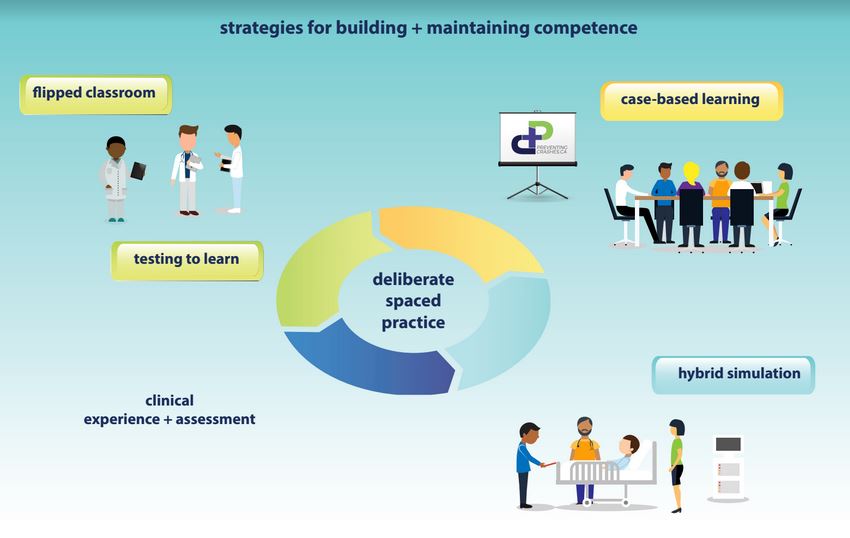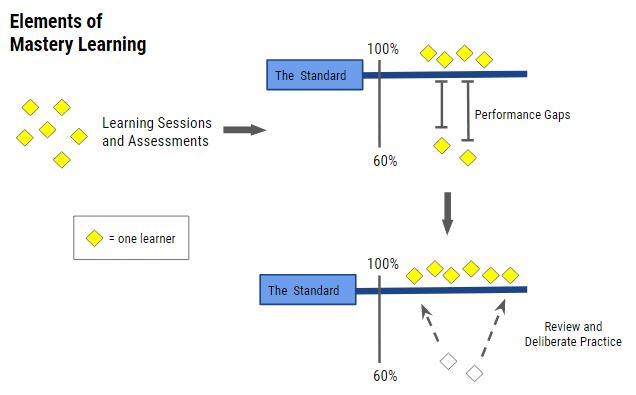To support mastery learning, the Competent Care model uses various educational strategies, described below. These strategies include assessment as an integral part of supporting learning.
The Flipped Classroom
The flipped classroom provides ‘lecture’ material in advance of class, and instead uses class time for clarifying questions, working through problems or cases, and allowing practice with feedback.
We use the flipped classroom by providing Open-Access content, including text, images, and videos, ahead of learning sessions that involve case discussions and simulations.
Testing to Learn
High pass rates on multiple choice questions and skills checklists are required to successfully complete mastery learning modules, and we offer these to organizations who wish to certify staff.
However, assessment tools have powerful uses beyond their role in certification. One of the most effective ways of consolidating learning is to be tested on it, and these assessment tools are freely provided to learners to use as often as the would like, for practice and to receive feedback on areas for growth.
Case-Based Learning
Case-based learning (CBL) is a popular method of engaging learners in active, inquiry-based learning. In our learning model, groups of learners are led through a clinical scenario by a facilitator, who is familiar with the answers and guides the discussion to ensure all points are covered.
Advance preparation is very helpful, and learners do well to review relevant topics beforehand – the flipped classroom approach. This allows for integration and consolidation of knowledge during the session. However, to maximize critical thinking, the cases themselves are password protected, and learners cannot access them until after the learning session.
Hybrid Simulations

Laerdal’s Shocklink system, with mannikin
The Competent Care program uses hybrid simulations as a cornerstone for learning, with actors for clinical presentations where dialogue and clinical assessment are needed, and simulations where procedures are required. The simulators we use are high-fidelity, low-technology, that is, they appropriately represent the clinical experience using the least amount of technology needed. We provide information on options for building or purchasing simulators and task trainers.
Facilitators guide simulations using open-access guides that are also password-protected from learners in advance of learning sessions. Simulations are introduced through briefing and conclude through debriefing. As appropriate, facilitators may assess individual learners using checklists to support mastery learning. Extensive training is provided to facilitators to support them in these roles.
Learning Sessions
Learning ideally occurs in groups of up to eight learners, and led by 1-2 facilitators, in order to promote participatory learning and to assist with ease of implementation.
Sessions may be brief, lasting 5-15 minutes to run through a case or simulation – or may include a combination of cases and simulations. Many organizations find a two hour session is ideal to build learning, maintain focus, and allow for ease of scheduling feasibility.
More on Mastery Learning
Mastery learning embraces concern for patient safety and outcomes, while also building sufficient confidence in the learner. It is contrasted with the more traditional ‘see one, do one, teach one’ model, where learners may provide care to real patients after limited exposure and without demonstrated competence.
To support mastery learning, educational strategies are offered small groups of learners. Using a variety of assessment tools, learners are compared to the standard, specific for the topics or domains of interest. If learners do not attain the standard, performance gaps are clarified. These gaps may be addressed through review and deliberate practice until the standard is reached.
Mastery is not maintained without practice, and our resources are designed to allow regular ‘top-ups’ to help learners and clinicians assess and regain competence.
For detailed information on each of these educational strategies, please visit our educational theory page.


